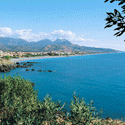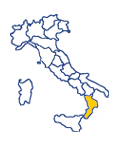|
|
|
Basilicata & Calabria Guide Italy
|
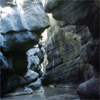 |
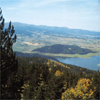 |
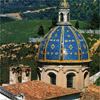 |
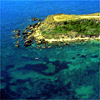 |
| Pollino Massif |
Ariamacina Lake |
Church of Corigliano Calabro |
Capo Rizzuto |
Directories of Web Sites:
Basilicata & Calabria Italy
Basilicata & Calabria Hotels
Basilicata & Calabria Guide
On travel between the Calabrian mountains, in a great land of wonderfull beauty, in a region bounded with two seas of around eight hundred kilometers coast limit, where for tis particular configuration, measureless views are present and where "the nature has plot in a magnificient way the lines that talent and human work must follow, or art efforts can improved".
Calabrian land must not only be limited to approach, even if essential, cliffs and beaches but also must look fro the centuries-old roots, the unpulluted and superb environment, traditions and ethnics that has been survived along the time because of generosity of the nature. Closed in the north with the Pollino and Orsomarso imponent reliefs, Calabria has a predominantly territory mountainous, large green reserves, and lakes with strong splendor inside Sila, demoted summit to peak into the sea on the Range Coast, very high silver firs and rushing streams on the Serre, the last window on the Meditterranean between the Aspromonte summits.
Eternal clashes, legendary stories of shepherds and brigands about unaccessible pathes, a continuous alternate between harmonious reliefs and vertical summits, unlike places "with fancy and queerness", that fascinate and disconcern, as vegetation and fauna, unexpected and unforeseen, make you think "to be in Scotland" two steps distant from the Mediterranean maquis. A world to explore, where nature is confused with ancient civilization shapes, rediscovering protected centres, churches, monasteries, castles, ancient palaces, traditions, art and folklore, languages and dialect always different; and then lots of amusement occasions for lovers of adventure, of ski, of nature, of hiking, of extreme sport.
The synthesis of a trip that different authors had told with precision and knowledge: as a trip fellow of the XIX century aristocrat, Norman Douglas, author of Old Calabria, maybe the best book written about the region, which narrates the atmosphere of the beginning of 19th century where valleys and Calabrian mountains are described with love and wonder.
Calabria boasts almost 800 km of coast washed by the waters of the Tyrrhenian, of the Straits of Messina and then, on the opposite side, by the Ionian Sea. Castles and watch towers are also characteristic sights along the Tyrrhenian coast, starting from the one built by Charles V at Amantea, a fortress town that was later embellished by the Franciscans who left several traces of their presence, the most outstandig of which is the churhc of San Bernardino da Siena (1436). On the Ionic strip there were three city states and three ancient civilization: Sibari, Crotone and Locri. They shared the same roots in Magna Graecia, being founded by Greek colonists between the 7th and the 6th century B.C., and for a long time they were in conflict with one anotehr: Kroton won the day over Sybaris, buth the succumbed, in the battle of the fair, to Locri Epizephiri. But in the intervals between the battles, wiht the inevitable intervention of various divinities, there were long periods of plendour in the arts and in philosophy. Pythagoras founded his school at Crotone, while at Locri Zaleucus dictated his laws, creating the first written code of laws in the Western World. The most prestigious gymnasiums of the Olympic athletes of the time were at Sibari and it was here that Strabo dictated the example that historians were to follow: "seventy days were enough to destroy the rich and famous town. In 572 B.C. the people of Croton defeated those of Sibari". In the early 1980s a famous archaeological find became the symbol of Calabria: the Riace Bronzes. They are the two stupendous Greek statues dredged from the sea and exhibited, from the early 1980s, in the Museo Nazionale della Magna Grecia in Reggio Calabria, one of the most important archaeological museums of all the Italian Peninsula. One of the two bronze statues is attributed to Fidia, the master Greek sculptor of the Vth century and famous for the reliefs of the Parthenon. Since their exposure at the Museo Nazionale hundreds of thousands of visitors arrived in Calabria to discover the marvellous archaeological and historical patrimony of this region.
Basilicata is a tiny southern region, occupied for the most part by mountains that in places reached by two seas: the Tyrrhenian sea for a short section of coast line, and the Ionian sea. It is one of the poorest region in Italy but it boast a piece of prehistory in the modern world: "The Sassi". They are located at Matera, the second main city of Basilicata, and UNESCO, the UN organisation that deals with education, science and culture, has proclaimed it to be the "heritage of humanity". The "caves of Matera" are one of the most peculiar, ancient and extraordinary human settlements in the world, which have drawn the attention of scholars and artists from all over the world (the Italian writer Carlo Levi spoke of them in his famous book "Christ stopped at Eboli"). In the "caves", the houses have been dug out of the tufa rock and the walls constructed with the excavated material. Inhabited until recently, the "caves" are now empty and have become the object of projects of cultural and touristic revaluation and restoration. A visit to the "caves of Matera" is a truly unique experience. But it is not the only reason to come to this small, secluded, and beautiful region boarded by two seas: the Tyrrhenian and the Ionian. In Basilicata there are Greek ruins (Metaponto), medieval churches and castles (Melfi, Lagopesole), beautiful beaches (Maratea), and unspoilt countryside (Basilicata shares the splendid park of Pollino with Calabria).And Matera does not only have its "caves": the remarkable blend of Romanesque and Baroque styles in the Church of S. Francesco, for example, is also fascinating. Finally, why not plan a visit to Venosa, birthplace of the great and wise Latin poet Horace? Here, among other attractions, it is possible to admire the medieval Abbey of SS. Trinità and other interesting monuments. In the regional capital, Potenza, ancient and recent earthquakes have seriously damaged the historic centre. But the archaeological museum merits a visit.(The Contents and the Photos of Calabria have been taken from "Calabria" by Assessorato Regionale al Turismo. The Contents for Basilica by ENIT 's Official Website) |
|
|
|
Acquista la tua visibilità su Travel Plan
|
|
|
|

